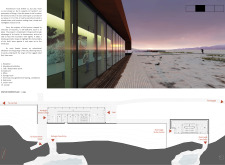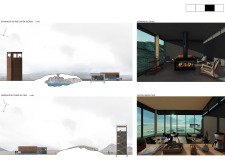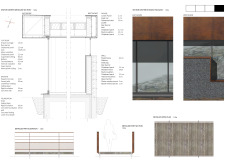5 key facts about this project
The core function of the visitor center is to provide information and exhibitions related to the geological formations characteristic of the region. It emphasizes the coexistence of human activities and natural processes, offering an immersive experience that fosters a deeper understanding of the environment. The layout includes the main visitor center and an observation tower, facilitating diverse interactions with the site, which enhances the overall experience.
Design Approaches and Unique Elements
The architectural design employs a duality concept—represented by the two distinct structures: the visitor center (Kvennagjá) and the observation tower (Karlaði). This duality embodies a dialogue between earth and sky, with the visitor center integrating closely with the terrain while the observation tower provides expansive views of the mountainous vista.
Materiality is a crucial aspect of this project, with selected materials intended to blend seamlessly with the surroundings. Corten steel is utilized for the facades, providing an earthy tone that mimics the natural landscape. Large glass panels are incorporated throughout the design, maximizing natural light and promoting a continuous visual connection between indoor and outdoor spaces. These material choices not only contribute to aesthetic quality but also address aspects of durability and sustainability.
Sustainability is paramount in the architectural approach, as geothermal heating and natural ventilation systems are integrated to reduce energy consumption. The combination of durable materials and environmentally conscious design reflects a commitment to ecological integrity and harmony with the site.
Exploration of Spatial Organization
The spatial layout invites visitors to navigate the site through planned pathways connecting the visitor center and the observation tower. The circulation routes are designed to enhance the visitor experience, creating moments of intimacy and expansive vistas. The visitor center is organized to facilitate educational exhibits, while the observation tower serves as a point of contemplation and observation.
This architectural design stands out due to its emphasis on geological education and the use of natural materials that create a seamless connection to the landscape. The project embodies a respect for environmental context and a commitment to sustainable architectural practices. Exploring the architectural plans, architectural sections, and architectural designs provides deeper insight into the thoughtful methodologies employed in this project, encouraging a comprehensive understanding of its significance and impact.


























